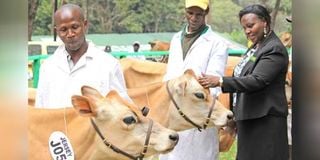Premium
On the tough trail of a Jersey bull

Jersey cows at the Nairobi International Trade Fair. The dairy industry depends on other productive agricultural activities that are affected by rains, including the growing of feed.
I have been working with farmers and helping them source livestock and pets of various species, breeds and gender.
But my experience over the last one year has emphasised the shortage of particular breeds of cattle.
As I mentioned in an earlier article, the 2022-2023 drought caused a slump in the breeding of cattle due to shortage and high cost of feeds and feed raw materials. This occasioned a shortage of breeding stock, especially for dairy cattle.
The shortage still exists because breeding is an operation that has well-defined timelines and abundance of uncertainty. It will take three to four years to recover from the effects of the devastating drought.
I explained to some farmers the impact of the drought and what it means to the resumption of normal availability of breeding stock in the market.
The initial reaction was that with the rains back and in plenty, the market would soon be flooded with breeders.
Unfortunately, several hidden factors delay the build-up of breeding dairy cattle in the market.
First, it is the fact that the dairy industry depends on other productive agricultural activities that are affected by rains, including the planting, growing and harvesting of feed and fodder crops.
Boma Rhodes hay, for instance, takes about five months to grow and hit the market.
The second thing is that it takes a fairly long time to rehabilitate cattle once the feed is readily available, inseminate them and wait for nine months for them to calve down.
Heifer calves born take about 15 months to mature for insemination and another three months for them to be confirmed pregnant.
The recovery time accounted for this far is 29 months or roughly two and a half years.
When you take into account the uncertainties and inefficiencies of production activities, the estimate of a three to four-year recovery becomes a reality.
During the last one year, there has been a great demand for Jersey cattle breeding stock due to the drought situation, a raised demand by some neighbouring countries and a realisation by Kenyan farmers that the breed is well-suited to hot weather and limited land.
While I thought Jersey heifers are difficult to find, I confirmed last week that bulls are even more difficult to nail down.
A farmer I had assisted to source six pregnant Jersey heifers suddenly told me he had found out that there was no reliable artificial insemination service (AI) in his area.
Being a beginner, he had enquired widely and found out that people in his area used bulls as they mainly kept beef animals.
He wanted to keep high-quality Jersey cattle for milk and sell breeding heifers.
I confirmed to him that a good pure Jersey bull was his best solution for breeding his cows.
He was to collect the heifers I had identified in 10 days.
The seller of the heifers had said he would not wish to keep the animals beyond the 10 days because he was running low on feeds.
I put up an advertisement for a pure Jersey bull of about 11 to 15 months old in various forums.
I had calculated that the farmer would need to start using the bull for his cows in about seven months because his first heifer would calve in the next five months. It would need to be served 63 days after calving.
It, therefore, meant that an 11-month-old bull would start serving at the age of 18 months and 22 months for a 15-month-old bull. The bull search took me and my associate, David, to many parts of the country.
We thanked technology because, except from the purchase visit, all the others were by phone and pictures via WhatsApp.
The trail in search of the bull was filled with perils, including fraudsters.
A majority asked to be paid a viewing fee where they required we send some money in order for them to send pictures of the bulls.
Others asked we pay a deposit before we could go to see the animals.
They refused to send any photos without the demanded deposits.
Another group wanted us to pay the full amount while we actually identified their photos as internet grabs.
I concluded that many people planning to buy animals are being conned.
From that experience, I caution farmers to be extremely careful when sourcing for animals.
We often get complaints on our farmers’ forums of people who get conned but seeing how aggressive the fraudsters are was strong evidence of existence of the “trade”.
Intact dairy bulls are also rare because most dairy farmers dispose of the calves after drinking colostrum and the buyers castrate them early to grow and fatten them for meat.
This is because most dairy farmers have correctly adopted AI as their preferred breeding method.
Uniquely, dairy cattle are rarely booked because one can book and fail to buy.
Most sellers insist the buyer walks to the farm, identifies the animal they are buying, pays for it and takes it away immediately.
We missed several bulls because they were sold between the time we promised to go and view them and the time we actually confirmed we were setting off to the farms.
Finally, I got a farmer in Nandi County who had good Jersey bulls and identified one from photos he sent.
By the time David got to the farm the following morning, our choice bull had already been sold!
Fortunately, we settled on another older bull, paid for it and moved it to Kiambu County to join the pregnant heifers, before embarking on the journey to their new home.





